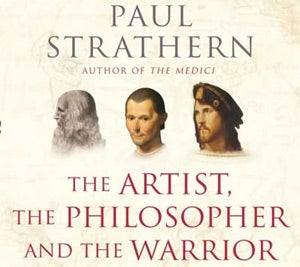The Artist, the Philosopher and the Warrior, By Paul Strathern
A gifted historical novelist struggles to unify this account of Leonardo, Machiavelli and a Borgia

In June 1502, Cesare Borgia, son of the infamous Pope Alexander VI, captured Urbino with a characteristically audacious stratagem: he announced that its Duke was dead (which was a lie), and installed himself in the duke's palace. Cesare was attempting to conquer the whole of the Romagna, which stretched from Bologna to Ancona. His exploits during the military campaign were, according to the young diplomat Niccolò Machiavelli, "accompanied by a unique good fortune, as well as superhuman daring and confidence that he can achieve what he wants".
Machiavelli had been despatched by the government of his native Florence, on whose lands the Pope's son was trespassing. "You must pledge to support me," Cesare told him, "If you do not want me as a friend, you will find me your enemy." Borgia had powerful allies (his father and the King of France) and Machiavelli had been instructed to appease him. As part of his charm offensive, he offered Cesare the services of the celebrated Florentine military engineer, and myriad-minded Renaissance genius, Leonardo da Vinci.
Borgia enthusiastically enlisted Leonardo as the technical guru of his military operations. Meanwhile, Machiavelli was instructed to keep a watchful eye on Cesare during what was to be a triumphant Romagnian crusade. So it was that the artist (Leonardo), the philosopher (Machiavelli) and the warrior (Borgia) of the title of Paul Strathern's interesting but flawed book, passed the autumn and winter months of 1502-3 together, talking and scheming their way across the Romagna, as city after city fell to Cesare.
Strathern deftly interweaves the narratives of his three main characters and successfully evokes their odyssey, drawing principally on Machiavelli's dispatches, which offer a chorus-like commentary on the unfolding drama. It comes as no surprise to learn that Strathern is a prize-winning novelist, as he has a sensitive ear for memorable phrases and a keen eye for striking detail. With considerable panache he serves up the scenes of murder, pillage, treachery and hedonistic excess with which the name of Borgia has become synonymous, and, in crisp and elegant prose, he explains the intricacies of 16th-century diplomacy, and keeps us up with all the entertaining court gossip.
Such, indeed, is Strathern's flair for vivid description and snappy dialogue that you can't help wishing, as you get a little way into this book, that he had written it as a novel. That reflection is also prompted by a consideration of the meagre historical evidence that has survived from the Romagna campaign, and of the way the author uses it. In a bid to cover up the gaps in the record he is often forced to stretch his flimsy facts to breaking point – and sometimes they snap.
For example, while he cautiously tells us on page 112 that Leonardo's notebooks contain three sketches that are "widely thought to be of Borgia", only a few pages later he confidently cites them as evidence of Cesare's brooding character. By page 317 his confidence has become certainty: he imagines Da Vinci "drawing those three portrait sketches of Borgia as he lay stretched out in his chair before the fire", before going on to deduce from them the artist's attitude to his master and to "the evil nature of men" in general.
Strathern frequently tries to flesh out the indistinct historical outline with this sort of pseudo-psychoanalytical speculation. Throughout, he recklessly attempts to decipher Leonardo's intimate thoughts and private feelings from his notoriously cryptic notebooks. "The very precision," he claims of certain notebook entries, can be read as evidence of the repression of tumultuous emotion. Given Sigmund Freud's spectacularly poor record on Leonardo – much of his famous analysis of the artist's life and the work is demonstrably wrong – the author should perhaps have taken him as a warning rather than as a model.
It leaves you wishing that Strathern had gone the whole hog and invented imaginary conversations. The fictional form would have allowed him to shape his narrative, which is unwieldy, over-long and often loses its momentum. There are too many extraneous and unconnected facts, and a number of repetitions – of scenes (Machiavelli's first encounter with Borgia), phrases and even of illustrations. A judicious edit would have made The Artist, The Philosopher and The Warrior a readable, though average, work of popular history; only a bold decision to cast it as fiction could have transformed it into something worthy of its gifted author.
Join our commenting forum
Join thought-provoking conversations, follow other Independent readers and see their replies
Comments